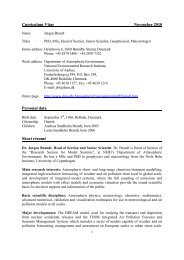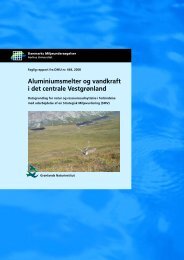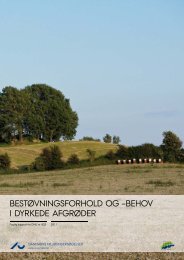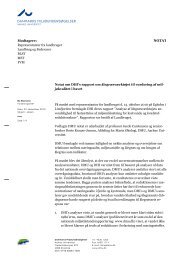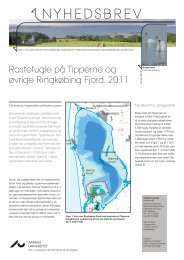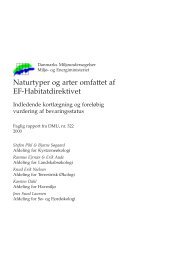Spatial distribution of emissions to air - the SPREAD model
Spatial distribution of emissions to air - the SPREAD model
Spatial distribution of emissions to air - the SPREAD model
You also want an ePaper? Increase the reach of your titles
YUMPU automatically turns print PDFs into web optimized ePapers that Google loves.
50<br />
'LVFXVVLRQ DQG SRWHQWLDO LPSURYHPHQWV<br />
This report describes <strong>the</strong> first version <strong>of</strong> <strong>SPREAD</strong>. During <strong>the</strong> work process<br />
on setting up <strong>the</strong> <strong>model</strong> a number <strong>of</strong> potential improvements has<br />
been identified. In some cases <strong>the</strong> necessary data are available but is not<br />
yet implemented in <strong>the</strong> inven<strong>to</strong>ry calculations or in <strong>SPREAD</strong>. In o<strong>the</strong>r<br />
cases it is not known if data required for improvements exists and if it<br />
can be made available for use in <strong>the</strong> inven<strong>to</strong>ry system or in <strong>SPREAD</strong>.<br />
The potential improvements are described in <strong>the</strong> following paragraphs.<br />
In all cases it will be considered both if it is possible <strong>to</strong> include <strong>the</strong> improvement<br />
and if <strong>the</strong> benefit <strong>of</strong> <strong>the</strong> improvement is in proportion with<br />
<strong>the</strong> required workload <strong>of</strong> implementation.<br />
6WDWLRQDU\ FRPEXVWLRQ SRLQW VRXUFHV<br />
In 2010 work has been carried out <strong>to</strong> improve <strong>the</strong> correctness <strong>of</strong> <strong>the</strong> EPT<br />
(database from <strong>the</strong> DEA including fuel consumption for each district<br />
heating or power-producing plant) e.g. all SNAP codes has been checked<br />
and corrected according <strong>to</strong> <strong>the</strong> given facility type and size. The improved<br />
dataset will be included in <strong>the</strong> next version <strong>of</strong> <strong>SPREAD</strong>.<br />
6WDWLRQDU\ FRPEXVWLRQ DUHD VRXUFHV<br />
Improvements <strong>of</strong> <strong>the</strong> conversions will be incorporated if possible. The<br />
Regional Inven<strong>to</strong>ry <strong>of</strong> energy consumption for heating for oil boilers, natural<br />
gas boilers and solid fuel installations by <strong>the</strong> Danish Energy Agency<br />
used for <strong>distribution</strong> <strong>of</strong> part <strong>of</strong> <strong>the</strong> <strong>emissions</strong> from stationary combustion<br />
from area sources at SNAP 01, 02 and 03, is made for <strong>the</strong> year 2005.<br />
It would improve <strong>the</strong> <strong>distribution</strong> <strong>to</strong> use an updated data set for <strong>the</strong> latest<br />
his<strong>to</strong>rical year. The Regional Inven<strong>to</strong>ry is based on data from <strong>the</strong><br />
Building and Housing Register (BBR) by <strong>the</strong> end <strong>of</strong> 2005. In 2009 a new<br />
version <strong>of</strong> BBR was released and inclusion <strong>of</strong> this new BBR could lead <strong>to</strong><br />
a better <strong>distribution</strong>. Wood combustion in residential plants is an important<br />
source for a number <strong>of</strong> pollutants, e.g. particulate matter, PAHs and<br />
some heavy metals. In <strong>the</strong> present <strong>model</strong> <strong>emissions</strong> from residential<br />
wood combustion are distributed on municipality level according <strong>to</strong> <strong>the</strong><br />
Regional Inven<strong>to</strong>ry. To improve this part a <strong>model</strong> for <strong>distribution</strong> <strong>of</strong><br />
<strong>emissions</strong> from residential wood combustion created in <strong>the</strong> research project<br />
WOODUSE could be applied. This <strong>model</strong> is based on a bot<strong>to</strong>m-up<br />
approach where <strong>the</strong> heating requirements are estimated on address<br />
level. Data from BBR are used as input in <strong>the</strong> <strong>model</strong> and a number <strong>of</strong> criteria<br />
are set up for estimation <strong>of</strong> <strong>the</strong> heating requirements, here among a<br />
selection <strong>of</strong> which addresses should be included in <strong>the</strong> <strong>model</strong>. Before a<br />
potential implementation <strong>of</strong> this sub-<strong>model</strong>, <strong>the</strong> criteria and equations<br />
will be re-evaluated. A detailed description <strong>of</strong> <strong>the</strong> <strong>model</strong> is required if it<br />
is implemented in a later version <strong>of</strong> <strong>SPREAD</strong>.





